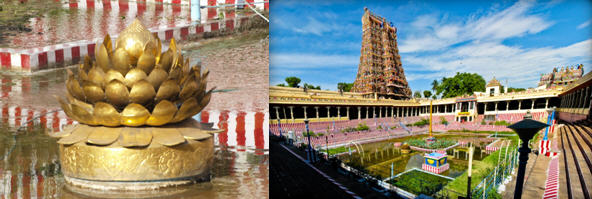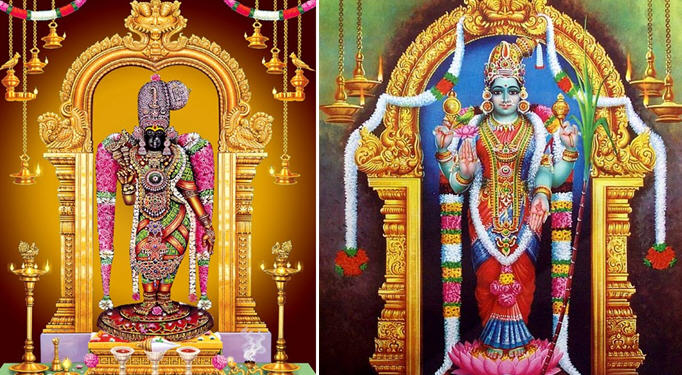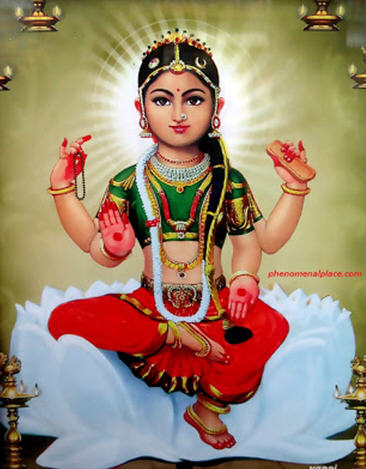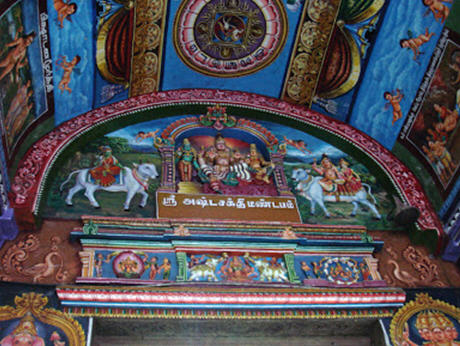
Lord Sundareswarar (Shiva) the consort of Goddess Meenakshi is to the north of KilikoontuMandapam .The deity of Sundarar is a Lingam. Kulasekara Pandyan, the grandfather of Meenakshi established the temple around this self manifested Lingam here.
On your way you can worship a gigantic deity of Sri Ganesh called MukkuriniPillaiyar. When the king Thirumalai Nayakar excavated a temple tank 3 km from Meenakshi temple he unearthed this deity of Vinayaka and erected the same here.

In the outer pragaram (corridor outside the main shrine) there is stump of the kadamba tree, which is said to be a part of the same tree under which Indra worshipped Shiva linga. Also in the outer corridor there are the Kadambathadi Mandapam and big hall called ‘VelliAmbalam’. Here, a beautiful deity of Nataraja (Shiva as the Lord of Dance) is seen. This deity of Nataraja is covered with silver leaves. Hence this hall is named as VelliAmbalam (Silver Hall)
.. 
Potramaraikulam (Golden lotus tank)
This temple tank is an ancient tank where devotees take bath in the holy water. The area around this tank was the meeting place of the Tamil Sangam – the ancient academy of poets. This academy judged the worth of any work of literature presented before it by throwing it into the tank. Only those that did not sink were considered worthy of attention. The tank is surrounded by a pillared corridor. Steps lead down to the tank, enabling worshippers to take bathe in it.

There is a nice story about this Golden lotus. Once Lord Indra had committed a terrible sin, and had to do a major penance to redeem himself. He came to Madurai, and decided to worship lord Shiva by offering 1000 lotuses. He was able to pluck 999 lotuses from the lake, but he couldn’t find one more lotus. Heart broken, Indra wept and prayed to lord Shiva. A golden lotus then bloomed from the center of the pond and Indra was able to redeem himself from his sin. That is why the temple tank is called PotramaraiKulam (Pon = Gold, Thamarai=Lotus).
Oonjal Mandapam

The Oonjal (swing) Mandapam and Killikoontu (parrot cage) Mandapam are on the western side of the tank. Every Friday, the utsav deities of Meenakshi and Sundareswarar are seated on the swing in the Oonjal Mandapam and hymns are sung as the deities swing to and fro. The parrots in the KilikoontuMandapam have been trained to repeat Meenakshi’s name. Interesting are also the 28 pillars of the mandapam which exhibit some excellent Sculptures of figures from vedic scriptures.
The Thousand Pillar Mandapam
It is the ‘wonder of the palace’. Actually the number of pillars count to 985 beautifully decorated columns. Each pillar is sculptured and is a monument of the Dravidan sculpture. There is a Temple Art Museum in this 1000 pillars hall where you can see icons, photographs, drawings, etc., exhibiting the 1200 years old history. There are so many other smaller and bigger mandapams in the temple.

Just outside this Mandapam ,towards the west, are the Musical Pillars. Each pillar when stuck, produces a different musical note. The kalyanamandapa, to the south of the pillared hall, is where the marriage of Shiva and Parvati is celebrated every year during the Chitirai Festival in mid- April.




